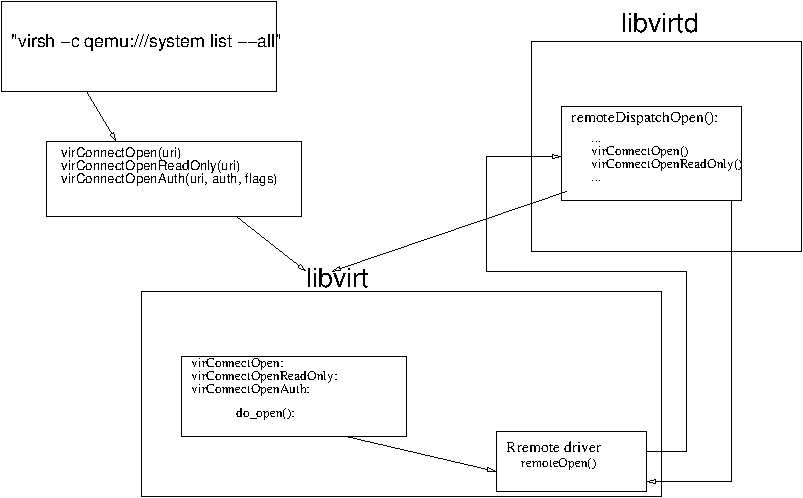While the content is slightly outdated it's still a good primer on how an API call traverses through the client library and to the remote driver. To make the page useful, this commit: - removes the paragraphs which were intended to serve as a directory page for the 'internals' subdirectory - adds a note saying that some facts might not be up to date - adds linking to this page from the kbase directory page - adds more monospace formatting around function names Signed-off-by: Peter Krempa <pkrempa@redhat.com> Reviewed-by: Michal Privoznik <mprivozn@redhat.com>
4.0 KiB
libvirt API call overview
The following diagram depicts code flow from a client application, in this case the libvirt provided virsh command through the various layers to elicit a response from some chosen hypervisor.
Note: Some aspects of this document may be outdated.
virsh -c qemu:///system list --allAfter the virsh code processes the input arguments, it eventually will make a call to open the connection using a default set of authentication credentials (
virConnectAuthDefault).virConnectOpenAuth()Each of the
virConnectOpenAPIs will first callvirInitialize()and then revector through the local "do_open()" call.virInitialize()Calls the registration API for each of the drivers with client-side only capabilities and then call the
remoteRegister()API last. This ensures thevirDriverTab[]tries local drivers first before using the remote driver.Loop through
virDriverTab[]entries trying to call their respective "open" entry point (in our caseremoteOpen())After successful return from the
virDriverTab[]open()API, attempt to find and open other drivers (network, interface, storage, etc.)
remoteOpen()After a couple of URI checks, a call to
doRemoteOpen()is madeDetermine network transport and host/port to use from URI
The transport will be either
tls,unix,ssh,libssh2,ext, ortcpwith the default oftls. Decode the host/port if provided or default tolocalhost.virNetClientRegisterAsyncIO()Register an I/O callback mechanism to get returned data via
virNetClientIncomingEvent()call(...REMOTE_PROC_OPEN...)Eventually routes into
virNetClientProgramCall()which will callvirNetClientSendWithReply()and eventually usesvirNetClientIO()to send the message to libvirtd and then waits for a response usingvirNetClientIOEventLoop()virNetClientIncomingEvent()Receives the returned packet and processes through
virNetClientIOUpdateCallback()
libvirtd Daemon
Daemon Startup
The daemon initialization processing will declare itself as a daemon via a
virNetDaemonNew()call, then creates new server usingvirNetServerNew()and adds that server to the main daemon struct withvirNetDaemonAddServer()call. It will then usevirDriverLoadModule()to find/load all known drivers, set up an RPC server program using theremoteProcs[]table via avirNetServerProgramNew()call. The table is the corollary to theremote_procedureenum list in the client. It lists all the functions to be called in the same order. Once RPC is set up, networking server sockets are opened, the various driver state initialization routines are run from thevirStateDriverTab[], the network links are enabled, and the daemon waits for work.RPC
When a message is received, the
remoteProcs[]table is referenced for theREMOTE_PROC_OPENcall entry. This results inremoteDispatchOpen()being called via thevirNetServerProgramDispatchCall().remoteDispatchOpen()The API will read the argument passed picking out the
nameof the driver to be opened. The code will then callvirConnectOpen()orvirConnectOpenReadOnly()depending on the argumentflags.virConnectOpen()orvirConnectOpenReadOnly()Just like the client except that upon entry the URI is what was passed from the client and will be found and opened to process the data.
The returned structure data is returned via the
virNetServerinterfaces to the remote driver which then returns it to the client application.
